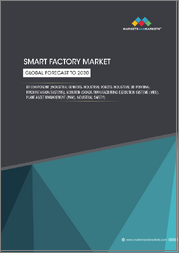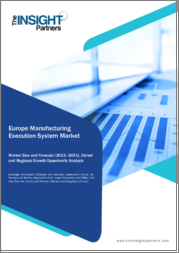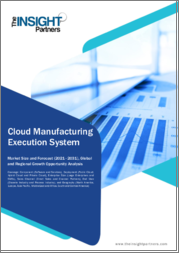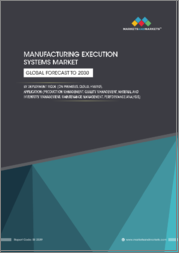
|
시장보고서
상품코드
1618571
세계의 제조 실행 시스템 시장 : 제공 제품, 기능, 산업, 전개별 예측(2025-2030년)Manufacturing Execution System Market by Offerings (Services, Software), Function (Data Collection & Acquisition, Dispatching Production, Inventory & Labor Management), Industry, Deployment - Global Forecast 2025-2030 |
||||||
제조 실행 시스템 시장의 2023년 시장 규모는 144억 달러로 평가되었습니다. 2024년에는 157억 7,000만 달러에 달할 것으로 예측되며, CAGR 9.74%로 성장하고, 2030년에는 276억 1,000만 달러에 달할 것으로 예상 예측됩니다.
제조 실행 시스템(MES)은 원재료에서 완성품으로의 변환을 추적·문서화함으로써 기업자원계획시스템과 제조현장의 교역 역할을 하는 통합 소프트웨어 솔루션입니다. 실시간 생산 모니터링, 의사 결정 효율 향상, 업무 생산성 개선 필요성으로 인해 발생합니다. MES는 자동차, 항공우주, 제약, 식품 및 소비재와 같은 다양한 분야에서 적용되며 운영의 합리화와 품질 관리를 보장하는 데 도움이 됩니다. 폐기, 낭비를 줄이고 업계 표준 준수를 유지함으로써 최종 이용 산업에서 매우 중요한 역할을 하고 있습니다.
| 주요 시장 통계 | |
|---|---|
| 기준년(2023) | 144억 달러 |
| 추정년(2024) | 157억 7,000만 달러 |
| 예측년(2030) | 276억 1,000만 달러 |
| CAGR(%) | 9.74% |
MES 시장은 제조업에서의 자동화와 데이터 교환을 중시하는 인더스트리 4.0과 IIoT(Industrial Internet of Things)의 채용 증가로 성장을 이루고 있습니다. 또한 스마트하고 커넥티드한 공장에 대한 수요 증가가 시장의 확대를 더욱 뒷받침하고 있습니다. 인공지능, 머신러닝, 블록체인 등의 신흥기술과 통합함으로써 예지보전, 데이터 분석, 공급체인의 투명성을 강화할 수 있는 큰 기회가 있습니다. 맞춤형 모듈식, 확장성 있는 솔루션 개발에 주력해야 합니다.
시장의 한계는 예산 제약으로 인한 중소기업의 도입률 지연과 MES 인프라 관리의 잠재적 기술 격차를 포함합니다. 인센티브 및 교육 프로그램이 중요합니다. 혁신이 필요한 분야로는 유연성을 제공하는 클라우드 기반 MES 솔루션 개발, MES를 다른 기업 솔루션과 결합한 통합 제품군의 출현, 데이터 주도 의사 결정을 위한 고급 분석 등이 포함됩니다. 그러므로 그 한계를 주의 깊게 회피하면 제조 효율과 생산성의 대폭적인 성장과 진화로 이어질 수 있습니다.
시장 역학: 빠르게 진화하는 제조 실행 시스템 시장의 주요 시장 인사이트 공개
제조 실행 시스템 시장은 수요 및 공급의 역동적인 상호작용에 의해 변모를 이루고 있습니다. 새로운 비즈니스 기회를 얻는 데 도움이 될 수 있습니다. 이러한 동향을 종합적으로 파악함으로써 기업은 정치적, 지리적, 기술적, 사회적, 경제적 영역에 걸친 다양한 위험을 완화할 수 있으며, 소비자 행동과 이는 제조 비용과 구매 동향에 미치는 영향을 더욱 명확하게 이해할 수 있습니다.
- 시장 성장 촉진요인
- 세계 각지에서의 제조 시설과 생산업무의 확대
- 제조 부문의 디지털화를 추진하고 공급망의 투명성을 향상시키는 정부의 대처
- 식품 및 제약 업계에서 첨단 추적 기능의 실현 요구
- 시장 성장 억제요인
- 제조실행시스템(MES)의 통합에 따른 어려움과 정밀도에 관한 문제
- 시장 기회
- MES의 정밀도, 성능, 효율을 향상시키기 위한 진보
- 제조 오퍼레이션의 지속가능성과 에너지 효율을 개선하기 위한 MES의 채용
- 시장의 과제
- 프라이버시 문제, 데이터 유출에 대한 우려
Porter's Five Force : 제조 실행 시스템 시장을 탐색하는 전략 도구
Porter's Five Force Framework는 시장 상황경쟁 구도를 이해하는 중요한 도구입니다. 기업이 시장 내 세력도를 평가하고 신규 사업의 수익성을 판단할 수 있도록 도와줍니다. 당신은 더 강인한 시장에서 포지셔닝을 보장할 수 있습니다.
PESTLE 분석 : 제조 실행 시스템 시장에서 외부로부터의 영향 파악
외부 거시 환경 요인은 제조 실행 시스템 시장의 성과 역학을 형성하는 데 매우 중요한 역할을합니다. 영향을 탐색하는 데 필요한 정보를 제공합니다. PESTLE 요인을 조사하면 기업은 잠재적인 위험과 기회를 더 잘 이해할 수 있습니다. 적극적인 의사 결정을 할 준비가되어 있습니다.
시장 점유율 분석 : 제조 실행 시스템 시장 경쟁 구도 파악
제조 실행 시스템 시장의 상세한 시장 점유율 분석을 통해 공급업체의 성과를 종합적으로 평가할 수 있습니다. 이를 통해 시장의 집중, 단편화, 통합 동향을 밝혀내고, 벤더는 경쟁이 격화하는 가운데 자신의 지위를 높이는 전략적인 의사결정을 할 필요가 있습니다.
FPNV 포지셔닝 매트릭스 : 제조 실행 시스템 시장에서 공급업체의 성능 평가
FPNV 포지셔닝 매트릭스는 제조 실행 시스템 시장에서 벤더를 평가하는 중요한 도구입니다. 네 가지 사분면을 통해 벤더를 명확하고 정확하게 분할하고 전략 목표에 가장 적합한 파트너 및 솔루션을 파악할 수 있습니다.
전략 분석 및 권장 : 제조 실행 시스템 시장에서 성공에 대한 길을 그리기
제조 실행 시스템 시장의 전략 분석은 세계 시장에서의 프레즌스 강화를 목표로 하는 기업에 필수적인 요소입니다. 이 접근법을 통해 경쟁 구도에서 과제를 극복하고 새로운 비즈니스 기회를 활용하여 장기적인 성공을 거둘 수 있는 체제를 구축할 수 있습니다.
이 보고서는 주요 관심 분야를 포괄하는 시장의 종합적인 분석을 제공합니다.
1. 시장 침투: 현재 시장 환경의 상세한 검토, 주요 기업의 광범위한 데이터, 시장 도달범위 및 전반적인 영향력 평가.
2. 시장 개척도: 신흥 시장의 성장 기회를 파악하고 기존 분야의 확장 가능성을 평가하며 미래 성장을 위한 전략적 로드맵을 제공합니다.
3. 시장 다양화: 최근 제품 출시, 미개척 지역, 업계의 주요 진보, 시장을 형성하는 전략적 투자를 분석합니다.
4. 경쟁 평가 및 정보 : 경쟁 구도를 철저히 분석하여 시장 점유율, 사업 전략, 제품 포트폴리오, 인증, 규제 당국 승인, 특허 동향, 주요 기업의 기술 진보 등을 검증합니다.
5. 제품 개발 및 혁신 : 미래 시장 성장을 가속할 것으로 예상되는 최첨단 기술, R&D 활동, 제품 혁신을 강조합니다.
또한 이해관계자가 충분한 정보를 얻고 의사결정을 할 수 있도록 중요한 질문에 대답하고 있습니다.
1. 현재 시장 규모와 향후 성장 예측은?
2. 최고의 투자 기회를 제공하는 제품, 부문 및 지역은 어디입니까?
3. 시장을 형성하는 주요 기술 동향과 규제의 영향은?
4. 주요 벤더의 시장 점유율과 경쟁 포지션은?
5. 벤더 시장 진입·철수 전략의 원동력이 되는 수익원과 전략적 기회는 무엇인가?
목차
제1장 서문
제2장 조사 방법
제3장 주요 요약
제4장 시장 개요
제5장 시장 인사이트
- 시장 역학
- 성장 촉진요인
- 세계에서 제조시설과 생산업무를 확대
- 제조업의 디지털화를 추진해, 공급 체인의 투명성을 향상시키는 정부의 대처
- 식품 및 음료·의약품 업계에 있어서의 고도의 추적 기능의 실현의 필요성
- 억제요인
- 제조 실행 시스템(MES)의 통합에 따른 어려움과 정밀도에 관한 문제
- 기회
- MES의 정밀도, 성능, 효율을 향상시키는 진보
- 제조업무의 지속가능성과 에너지 효율을 향상시키기 위한 MES 도입
- 과제
- 데이터 침해와 관련된 프라이버시 문제와 우려
- 성장 촉진요인
- 시장 세분화 분석
- 제공 내용 : MES 소프트웨어의 성능을 향상시키는 진보
- 기능: 컴플라이언스, 법적 데이터 수집 및 취득 확보를 위한 노력
- 업계: 식품 및 음료 업계에 있어서의 규제 준수의 필요성 증가
- 배포 : 확장 성을 실현하기위한 클라우드상의 배포 솔루션 채택
- Porter's Five Forces 분석
- PESTEL 분석
- 정치적
- 경제
- 사교
- 기술적
- 법률상
- 환경
제6장 제조 실행 시스템 시장 : 제공 제품별
- 서비스
- 실장 및 유지보수
- 소프트웨어 업그레이드
- 교육 및 지원
- 소프트웨어
제7장 제조 실행 시스템 시장 : 기능별
- 데이터 수집 및 취득
- 생산 파견
- 재고관리와 노무관리
- 운영 스케줄 및 관리
- 퍼포먼스 분석
- 프로세스 관리
- 생산 추적
- 품질 분석
- 자원 할당
제8장 제조 실행 시스템 시장 : 업계별
- 항공우주 및 방어
- 자동차
- 화학약품
- 소비재
- 일렉트로닉스 및 반도체
- 에너지 및 전력
- 식품 및 음료
- 금속 및 광업
- 석유 및 가스
- 제약 및 생명과학
- 펄프 및 종이
- 물 및 폐수 관리
제9장 제조 실행 시스템 시장 : 전개별
- 클라우드상
- 온프레미스
제10장 아메리카의 제조 실행 시스템 시장
- 아르헨티나
- 브라질
- 캐나다
- 멕시코
- 미국
제11장 아시아태평양의 제조 실행 시스템 시장
- 호주
- 중국
- 인도
- 인도네시아
- 일본
- 말레이시아
- 필리핀
- 싱가포르
- 한국
- 대만
- 태국
- 베트남
제12장 유럽·중동 및 아프리카의 제조 실행 시스템 시장
- 덴마크
- 이집트
- 핀란드
- 프랑스
- 독일
- 이스라엘
- 이탈리아
- 네덜란드
- 나이지리아
- 노르웨이
- 폴란드
- 카타르
- 러시아
- 사우디아라비아
- 남아프리카
- 스페인
- 스웨덴
- 스위스
- 터키
- 아랍에미리트(UAE)
- 영국
제13장 경쟁 구도
- 시장 점유율 분석 2023
- FPNV 포지셔닝 매트릭스, 2023
- 경쟁 시나리오 분석
- Minaris Regenerative Medicine, Werum PAS-X MES 3.3을 도입하여 디지털 생산으로 이행하여보다 빠르고 종이없는 배치 처리를 실현
- Aegis Software의 FactoryLogix MES 플랫폼의 최신 업데이트는 인간과 기계 모두에서 타의 추종을 불허하는 IIoT를 제공합니다.
- Korber와 TetraScience가 제휴해, 제조에 있어서의 데이터의 무결성 향상을 목표로 한다
- AVEVA, 새로운 제조 실행 시스템 소프트웨어를 발표
- 전략 분석과 제안
기업 목록
- ABB Ltd.
- Advantive
- Aegis Industrial Software Corporation
- Applied Materials, Inc.
- Dassault Systemes SE
- Emerson Electric Co.
- Epicor Software Corporation
- FORCAM GmbH
- General Electric Company
- HCL Technologies Limited
- Honeywell International Inc.
- Infor, Inc
- Korber AG
- Mpdv Mikrolab GmbH
- Oracle Corporation
- Panasonic Holdings Corporation
- Parsec Automation Corporation
- Rockwell Automation, Inc.
- SAP SE
- Schnieder Electric SE
- Siemens AG
- Throughput Consulting, Inc.
The Manufacturing Execution System Market was valued at USD 14.40 billion in 2023, expected to reach USD 15.77 billion in 2024, and is projected to grow at a CAGR of 9.74%, to USD 27.61 billion by 2030.
Manufacturing Execution Systems (MES) are integrated software solutions that function as a bridge between enterprise resource planning systems and the manufacturing floor by tracking and documenting the transformation of raw materials to finished goods. The necessity of MES arises from the need for real-time production monitoring, enhancing decision-making efficiency, and improving operational productivity in manufacturing sectors. It finds application across various sectors such as automotive, aerospace, pharmaceuticals, food and beverage, and consumer goods, to streamline operations and ensure quality control. MES plays a pivotal role in end-use industries by minimizing production downtime, reducing wastage, and maintaining compliance with industry standards.
| KEY MARKET STATISTICS | |
|---|---|
| Base Year [2023] | USD 14.40 billion |
| Estimated Year [2024] | USD 15.77 billion |
| Forecast Year [2030] | USD 27.61 billion |
| CAGR (%) | 9.74% |
The MES market is experiencing growth, driven by the increasing adoption of Industry 4.0 and the Industrial Internet of Things (IIoT), which emphasize automation and data exchange within manufacturing. Moreover, the rising demand for smart and connected factories further fuels market expansion. However, key challenges include the high initial cost of MES implementation and the complexity of transitioning from legacy systems. Despite these challenges, there are substantial opportunities in integrating MES with emerging technologies such as artificial intelligence, machine learning, and blockchain, which can enhance predictive maintenance, data analytics, and supply chain transparency. To capitalize on these opportunities, businesses should focus on developing modular and scalable solutions that can be customized for different industrial needs.
Market limitations include the slow adoption rate in small and medium-sized enterprises due to budget constraints and a potential skills gap in managing MES infrastructure. To mitigate these, incentives for digital transformation and training programs could be crucial. Areas ripe for innovation include the development of cloud-based MES solutions that offer flexibility, the advent of integrated suites that combine MES with other enterprise solutions, and advanced analytics for data-driven decision-making. Overall, while the MES market presents a range of opportunities, careful navigation around its limitations can lead to substantial growth and evolution in manufacturing efficiency and productivity.
Market Dynamics: Unveiling Key Market Insights in the Rapidly Evolving Manufacturing Execution System Market
The Manufacturing Execution System Market is undergoing transformative changes driven by a dynamic interplay of supply and demand factors. Understanding these evolving market dynamics prepares business organizations to make informed investment decisions, refine strategic decisions, and seize new opportunities. By gaining a comprehensive view of these trends, business organizations can mitigate various risks across political, geographic, technical, social, and economic domains while also gaining a clearer understanding of consumer behavior and its impact on manufacturing costs and purchasing trends.
- Market Drivers
- Expansion of manufacturing facilities and production operations across the world
- Government initiatives to promote digitalization of the manufacturing sector and improve supply chain transparency
- Need to achieve advanced tracking capabilities in food and beverage and pharmaceutical industries
- Market Restraints
- Difficulties associated with the integration of manufacturing execution systems (MES) and issues related to accuracy
- Market Opportunities
- Advancements to improve the accuracy, performance, and efficiency of MES
- Adoption of MES to improve sustainability and energy efficiency of manufacturing operations
- Market Challenges
- Privacy issues and concerns associated with data breaches
Porter's Five Forces: A Strategic Tool for Navigating the Manufacturing Execution System Market
Porter's five forces framework is a critical tool for understanding the competitive landscape of the Manufacturing Execution System Market. It offers business organizations with a clear methodology for evaluating their competitive positioning and exploring strategic opportunities. This framework helps businesses assess the power dynamics within the market and determine the profitability of new ventures. With these insights, business organizations can leverage their strengths, address weaknesses, and avoid potential challenges, ensuring a more resilient market positioning.
PESTLE Analysis: Navigating External Influences in the Manufacturing Execution System Market
External macro-environmental factors play a pivotal role in shaping the performance dynamics of the Manufacturing Execution System Market. Political, Economic, Social, Technological, Legal, and Environmental factors analysis provides the necessary information to navigate these influences. By examining PESTLE factors, businesses can better understand potential risks and opportunities. This analysis enables business organizations to anticipate changes in regulations, consumer preferences, and economic trends, ensuring they are prepared to make proactive, forward-thinking decisions.
Market Share Analysis: Understanding the Competitive Landscape in the Manufacturing Execution System Market
A detailed market share analysis in the Manufacturing Execution System Market provides a comprehensive assessment of vendors' performance. Companies can identify their competitive positioning by comparing key metrics, including revenue, customer base, and growth rates. This analysis highlights market concentration, fragmentation, and trends in consolidation, offering vendors the insights required to make strategic decisions that enhance their position in an increasingly competitive landscape.
FPNV Positioning Matrix: Evaluating Vendors' Performance in the Manufacturing Execution System Market
The Forefront, Pathfinder, Niche, Vital (FPNV) Positioning Matrix is a critical tool for evaluating vendors within the Manufacturing Execution System Market. This matrix enables business organizations to make well-informed decisions that align with their goals by assessing vendors based on their business strategy and product satisfaction. The four quadrants provide a clear and precise segmentation of vendors, helping users identify the right partners and solutions that best fit their strategic objectives.
Strategy Analysis & Recommendation: Charting a Path to Success in the Manufacturing Execution System Market
A strategic analysis of the Manufacturing Execution System Market is essential for businesses looking to strengthen their global market presence. By reviewing key resources, capabilities, and performance indicators, business organizations can identify growth opportunities and work toward improvement. This approach helps businesses navigate challenges in the competitive landscape and ensures they are well-positioned to capitalize on newer opportunities and drive long-term success.
Key Company Profiles
The report delves into recent significant developments in the Manufacturing Execution System Market, highlighting leading vendors and their innovative profiles. These include ABB Ltd., Advantive, Aegis Industrial Software Corporation, Applied Materials, Inc., Dassault Systemes SE, Emerson Electric Co., Epicor Software Corporation, FORCAM GmbH, General Electric Company, HCL Technologies Limited, Honeywell International Inc., Infor, Inc, Korber AG, Mpdv Mikrolab GmbH, Oracle Corporation, Panasonic Holdings Corporation, Parsec Automation Corporation, Rockwell Automation, Inc., SAP SE, Schnieder Electric SE, Siemens AG, and Throughput Consulting, Inc..
Market Segmentation & Coverage
This research report categorizes the Manufacturing Execution System Market to forecast the revenues and analyze trends in each of the following sub-markets:
- Based on Offerings, market is studied across Services and Software. The Services is further studied across Implementation & Maintenance, Software Upgradation, and Training & Support.
- Based on Function, market is studied across Data Collection & Acquisition, Dispatching Production, Inventory & Labor Management, Operations scheduling & Management, Performance Analysis, Process Management, Production Tracking, Quality Analysis, and Resource Allocation.
- Based on Industry, market is studied across Aerospace & Defense, Automotive, Chemical, Consumer Packaged Goods, Electronics & Semiconductors, Energy & Power, Food & Beverages, Metal & Mining, Oil & Gas, Pharmaceutical & Life Sciences, Pulp & Paper, and Water & Wastewater Management.
- Based on Deployment, market is studied across On-Cloud and On-Premises.
- Based on Region, market is studied across Americas, Asia-Pacific, and Europe, Middle East & Africa. The Americas is further studied across Argentina, Brazil, Canada, Mexico, and United States. The United States is further studied across California, Florida, Illinois, New York, Ohio, Pennsylvania, and Texas. The Asia-Pacific is further studied across Australia, China, India, Indonesia, Japan, Malaysia, Philippines, Singapore, South Korea, Taiwan, Thailand, and Vietnam. The Europe, Middle East & Africa is further studied across Denmark, Egypt, Finland, France, Germany, Israel, Italy, Netherlands, Nigeria, Norway, Poland, Qatar, Russia, Saudi Arabia, South Africa, Spain, Sweden, Switzerland, Turkey, United Arab Emirates, and United Kingdom.
The report offers a comprehensive analysis of the market, covering key focus areas:
1. Market Penetration: A detailed review of the current market environment, including extensive data from top industry players, evaluating their market reach and overall influence.
2. Market Development: Identifies growth opportunities in emerging markets and assesses expansion potential in established sectors, providing a strategic roadmap for future growth.
3. Market Diversification: Analyzes recent product launches, untapped geographic regions, major industry advancements, and strategic investments reshaping the market.
4. Competitive Assessment & Intelligence: Provides a thorough analysis of the competitive landscape, examining market share, business strategies, product portfolios, certifications, regulatory approvals, patent trends, and technological advancements of key players.
5. Product Development & Innovation: Highlights cutting-edge technologies, R&D activities, and product innovations expected to drive future market growth.
The report also answers critical questions to aid stakeholders in making informed decisions:
1. What is the current market size, and what is the forecasted growth?
2. Which products, segments, and regions offer the best investment opportunities?
3. What are the key technology trends and regulatory influences shaping the market?
4. How do leading vendors rank in terms of market share and competitive positioning?
5. What revenue sources and strategic opportunities drive vendors' market entry or exit strategies?
Table of Contents
1. Preface
- 1.1. Objectives of the Study
- 1.2. Market Segmentation & Coverage
- 1.3. Years Considered for the Study
- 1.4. Currency & Pricing
- 1.5. Language
- 1.6. Stakeholders
2. Research Methodology
- 2.1. Define: Research Objective
- 2.2. Determine: Research Design
- 2.3. Prepare: Research Instrument
- 2.4. Collect: Data Source
- 2.5. Analyze: Data Interpretation
- 2.6. Formulate: Data Verification
- 2.7. Publish: Research Report
- 2.8. Repeat: Report Update
3. Executive Summary
4. Market Overview
5. Market Insights
- 5.1. Market Dynamics
- 5.1.1. Drivers
- 5.1.1.1. Expansion of manufacturing facilities and production operations across the world
- 5.1.1.2. Government initiatives to promote digitalization of the manufacturing sector and improve supply chain transparency
- 5.1.1.3. Need to achieve advanced tracking capabilities in food and beverage and pharmaceutical industries
- 5.1.2. Restraints
- 5.1.2.1. Difficulties associated with the integration of manufacturing execution systems (MES) and issues related to accuracy
- 5.1.3. Opportunities
- 5.1.3.1. Advancements to improve the accuracy, performance, and efficiency of MES
- 5.1.3.2. Adoption of MES to improve sustainability and energy efficiency of manufacturing operations
- 5.1.4. Challenges
- 5.1.4.1. Privacy issues and concerns associated with data breaches
- 5.1.1. Drivers
- 5.2. Market Segmentation Analysis
- 5.2.1. Offerings: Advancements to improve the performance of MES software
- 5.2.2. Function: Efforts to ensure compliance, legal data collection and acquisition
- 5.2.3. Industry: Growing need to achieve regulatory compliance in the food and beverage industry
- 5.2.4. Deployment: Adoption of on-cloud deployment solutions to achieve scalability
- 5.3. Porter's Five Forces Analysis
- 5.3.1. Threat of New Entrants
- 5.3.2. Threat of Substitutes
- 5.3.3. Bargaining Power of Customers
- 5.3.4. Bargaining Power of Suppliers
- 5.3.5. Industry Rivalry
- 5.4. PESTLE Analysis
- 5.4.1. Political
- 5.4.2. Economic
- 5.4.3. Social
- 5.4.4. Technological
- 5.4.5. Legal
- 5.4.6. Environmental
6. Manufacturing Execution System Market, by Offerings
- 6.1. Introduction
- 6.2. Services
- 6.2.1. Implementation & Maintenance
- 6.2.2. Software Upgradation
- 6.2.3. Training & Support
- 6.3. Software
7. Manufacturing Execution System Market, by Function
- 7.1. Introduction
- 7.2. Data Collection & Acquisition
- 7.3. Dispatching Production
- 7.4. Inventory & Labor Management
- 7.5. Operations scheduling & Management
- 7.6. Performance Analysis
- 7.7. Process Management
- 7.8. Production Tracking
- 7.9. Quality Analysis
- 7.10. Resource Allocation
8. Manufacturing Execution System Market, by Industry
- 8.1. Introduction
- 8.2. Aerospace & Defense
- 8.3. Automotive
- 8.4. Chemical
- 8.5. Consumer Packaged Goods
- 8.6. Electronics & Semiconductors
- 8.7. Energy & Power
- 8.8. Food & Beverages
- 8.9. Metal & Mining
- 8.10. Oil & Gas
- 8.11. Pharmaceutical & Life Sciences
- 8.12. Pulp & Paper
- 8.13. Water & Wastewater Management
9. Manufacturing Execution System Market, by Deployment
- 9.1. Introduction
- 9.2. On-Cloud
- 9.3. On-Premises
10. Americas Manufacturing Execution System Market
- 10.1. Introduction
- 10.2. Argentina
- 10.3. Brazil
- 10.4. Canada
- 10.5. Mexico
- 10.6. United States
11. Asia-Pacific Manufacturing Execution System Market
- 11.1. Introduction
- 11.2. Australia
- 11.3. China
- 11.4. India
- 11.5. Indonesia
- 11.6. Japan
- 11.7. Malaysia
- 11.8. Philippines
- 11.9. Singapore
- 11.10. South Korea
- 11.11. Taiwan
- 11.12. Thailand
- 11.13. Vietnam
12. Europe, Middle East & Africa Manufacturing Execution System Market
- 12.1. Introduction
- 12.2. Denmark
- 12.3. Egypt
- 12.4. Finland
- 12.5. France
- 12.6. Germany
- 12.7. Israel
- 12.8. Italy
- 12.9. Netherlands
- 12.10. Nigeria
- 12.11. Norway
- 12.12. Poland
- 12.13. Qatar
- 12.14. Russia
- 12.15. Saudi Arabia
- 12.16. South Africa
- 12.17. Spain
- 12.18. Sweden
- 12.19. Switzerland
- 12.20. Turkey
- 12.21. United Arab Emirates
- 12.22. United Kingdom
13. Competitive Landscape
- 13.1. Market Share Analysis, 2023
- 13.2. FPNV Positioning Matrix, 2023
- 13.3. Competitive Scenario Analysis
- 13.3.1. Minaris Regenerative Medicine Transitions to Digital Production with Werum PAS-X MES 3.3 for Faster, Paperless Batch Processing
- 13.3.2. Aegis Software's Latest Updates to the FactoryLogix MES Platform Enable Unmatched IIoT from Both Humans and Machines
- 13.3.3. Korber and TetraScience partner to increase data integrity in manufacturing
- 13.3.4. AVEVA Launches New Manufacturing Execution System Software
- 13.4. Strategy Analysis & Recommendation
Companies Mentioned
- 1. ABB Ltd.
- 2. Advantive
- 3. Aegis Industrial Software Corporation
- 4. Applied Materials, Inc.
- 5. Dassault Systemes SE
- 6. Emerson Electric Co.
- 7. Epicor Software Corporation
- 8. FORCAM GmbH
- 9. General Electric Company
- 10. HCL Technologies Limited
- 11. Honeywell International Inc.
- 12. Infor, Inc
- 13. Korber AG
- 14. Mpdv Mikrolab GmbH
- 15. Oracle Corporation
- 16. Panasonic Holdings Corporation
- 17. Parsec Automation Corporation
- 18. Rockwell Automation, Inc.
- 19. SAP SE
- 20. Schnieder Electric SE
- 21. Siemens AG
- 22. Throughput Consulting, Inc.



















